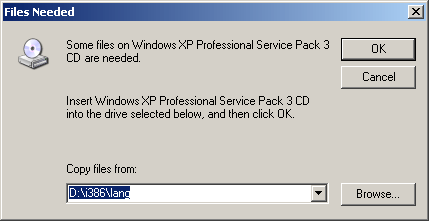Install Sp3 On Windows Xp Embedded Support

Installing Windows XP Embedded with Service Pack 2 by Mark Chamberlain, Nelson D'Souza, and Bill Pierson January 2005 Applies to Microsoft® Windows® XP Embedded with Service Pack 2 Summary The intent of this document is to serve as a single information source for Microsoft® Windows® XP Embedded OEM developers. Where applicable, this document references existing Microsoft public Web site links. Contents Introduction This document offers a guided approach for Microsoft® Windows® XP Embedded developers who are installing Windows XP Embedded with Service Pack 2 (SP2) for the first time, or are updating their Service Pack 1 development environment to Service Pack 2. If you are installing Windows XP Embedded for the first time: Windows XP Embedded with Service Pack 2 is a kit containing nine CDs. This document helps you to navigate the content of these CDs, and offers you a comprehensive step-by-step installation procedure. If you are updating an existing development environment (for example, SP1 to SP2), the steps you take depend on various factors such as: • Whether you are currently servicing shipped Windows XP Embedded with SP1-based devices. • Whether you plan to update all your field-deployed devices to SP2.
May 13, 2017 Download Security Update for Windows XP SP3 for XPe (KB4012598) from Official Microsoft Download Center. Windows XP Embedded Install. I am trying to find Service Pack 3 for Windows XP Embedded (possibly named WindowsXPESP3-June2009-x86-ENU.exe). The link present. Professional operating system that brings the rich feature set of Windows XP Professional to embedded devices. Importantly, Windows XP Embedded is engineered for embedded devices, and to support the work of the. Change Routeros Software Id there. System file protection, however, because embedded device users do not typically install software.
This document offers you recommendations based on your situation. Call.of.duty.modern.warfare.2 Razor1911 here. Why Update to SP2 Using SP2 extends the period of time for which Microsoft product support remains available.
Review your product support license for details. In addition to featuring improvements made to SP1, Windows XP Embedded with SP2 incorporates the same feature and software updates contained in Windows XP Professional SP2. These improvements and features include: • QFEs and updates incorporated into the operating system Over 800 software updates and fixes have been incorporated into SP2. This includes all applicable SP1 QFEs updates. The complete list is available. • New Windows XP SP2 features Key features introduced in SP2 include improved security, improved wireless support, Bluetooth technology, and DirectX updates. For detailed information about Windows XP SP2 features, see.
For additional support information for SP2 features, see. • Comprehensive component help Component help is now included for all components (approximately 12,000). • Windows XP Embedded Enabling Features The Hibernate Once, Resume Many (HORM) feature is a new capability in the Enhanced Write Filter (EWF) that offers a means of fast-booting your XP Embedded device from a hibernation file.
Another new EWF feature is the ability to complete a commit function without requiring a system reboot, if using EWF with RAM overlays (EWF-RAM). A new component, named Generic Device Drivers, offers a means of installing major classes of device drivers into your run-time image. This is accomplished by dividing the driver.cab file into smaller files sorted by device class, and then offering the developer a means of picking and choosing which device classes are included in the run-time image. Update Considerations This section discusses your deployment options when updating your development system and process from SP1 to SP2. One of the first things to understand is the way Windows XP Embedded component versioning works.
The Windows XP Embedded Component Database is designed to allow multiple component versions to coexist, for any component. The key behaviors are as follows: • When you use Target Designer to add a component to your run-time image configuration, Target Designer always uses the latest revision of that component that it finds in the database. Download Game Hp Csl Blueberry G7c. When you save your Target Designer configuration, the configuration remembers the specific version of each component that was used when you designed the configuration. If you later add a newer revision of a component to your database (such as a QFE update or hotfix), and then you reload your Target Designer configuration, some components may be flagged with blue up-arrows on top of their icons.
This indicates that you have the option to update the component. If the Configuration Upgrade check box is set on the Advanced tab of the Options dialog box and your configuration contains upgradeable components, Target Designer asks whether you wish to update a configuration. If you choose not to update, the configuration continues to use the original (older) version of the component. • When you choose Check Dependencies from the Configuration menu and the tool determines that a new component needs to be installed in order to satisfy component dependencies, the latest revision found in the database is always used when Target Designer resolves dependencies. Note Generally, you should always have Auto-resolve dependencies turned on, to ensure that component dependencies are always satisfied.